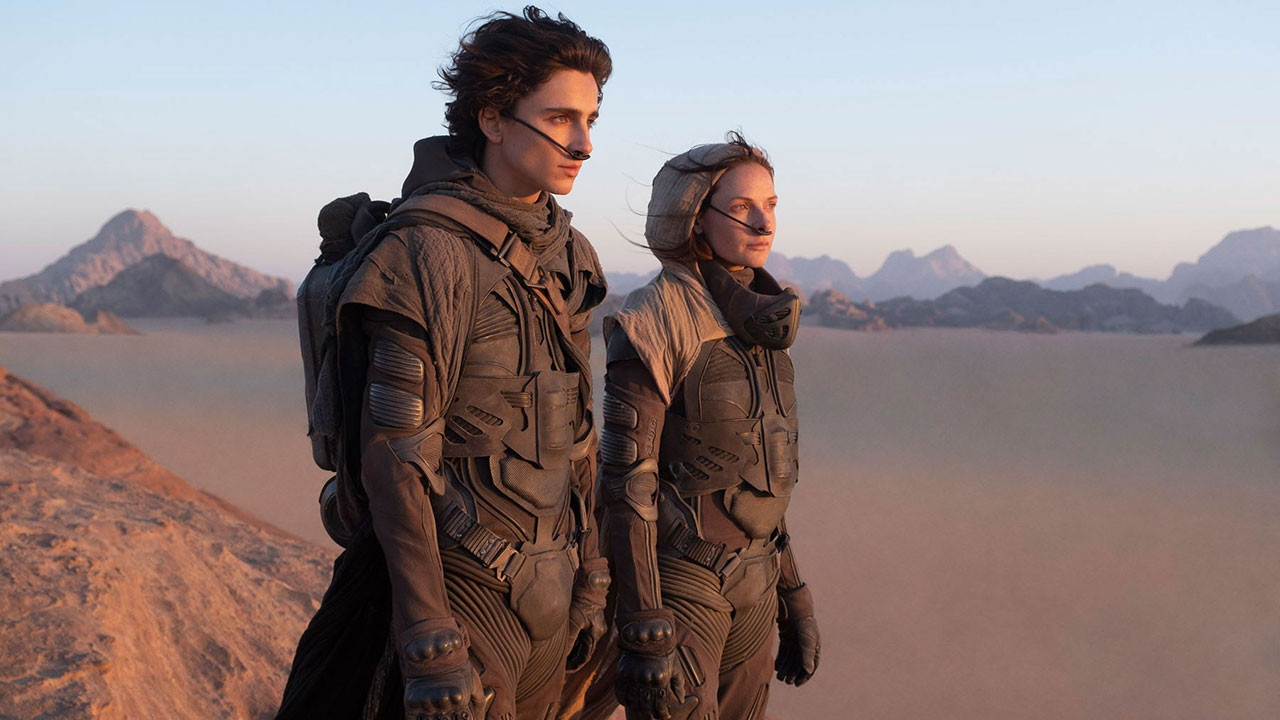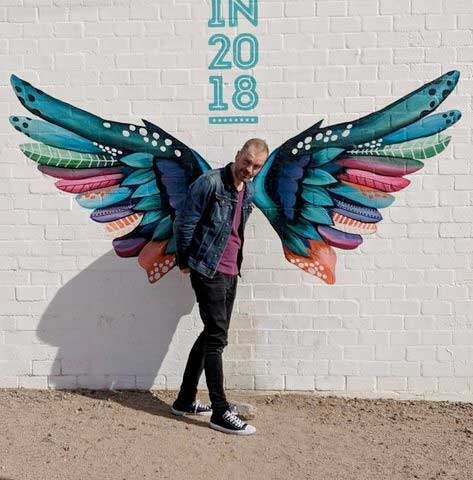A couple of years ago, actor Oscar Isaac outed himself as an unlikely stoner metal fan. Speaking to NME, the Star Wars and Inside Llewyn Davis star ran through his all-time favourite albums. Amid classics by Marvin Gaye and The Cure, one stood out like a bong in a toy shop: Dopesmoker, the hour-long hymn to weed by famed San Diego herb enthusiasts Sleep.
“[It’s] is actually just one epic, grinding track,” Isaac explained. “I’ll listen to this when I really just want to wallow, man. I call it ‘sludge metal’ or ‘metal meets Gregorian chants.’ It’s real head music, if you know what I mean.”
As well as showing impeccable taste, Isaac unwittingly foresaw a glimpse of his own future. The cover of the 2012 reissue of Dopesmoker featured an illustration by acclaimed US artist Arik Roper of a line of cowled nomads leading large, camel-like creatures across a desert.
These were the Weedians, referenced in the lyrics of Dopesmoker – an army of drug-priests traipsing across the sand of some unnamed planet to spread the word of their god, marijuana, kitted out in robes and tubes designed to recycle the smoke they're exhaling so they can remain perpetually stoned.
Except anyone with a knowledge of sci-fi knew that they were more than that. Roper’s image was inspired by Frank Herbert’s landmark 1965 sci-fi epic Dune, recently turned into a blockbuster movie directed by Denis Villeneuve and starring Timothée Chalamet, Jason Momoa and – oh, what? – our old friend Oscar Isaac.
The Weedians are essentially Fremen, the indigenous inhabitants of Arrakis, the desert planet at the centre of the Dune saga that’s famed for both its mind-altering drug Spice and the lethal giant sandworms that snake constantly beneath its surface. The robes and tubes are a nod to the Fremen’s ‘stillsuits’ – the outfits that allow them to survive on the planet’s arid surface by recycling bodily fluids (it’s definitely not weed in the books).
“Oh, that cover is totally inspired by Dune,” says Arik Roper, a fan of the saga. “I took a lot of cues from [bassist/vocalist] Al Cisneros’ lyrics, the way he describes these caravans in the desert, and went with it. The visual imagery of those books is astonishing. The vastness and open-ness of the desert suggests this infinite potential, plus there’s an aspect of Dune, with the Spice drug, that really ties in with psychedelics.”
It’s not the only Dune reference in Sleep’s back catalogue. Giza Butler, a track from their 2018 comeback album The Sciences, may have been a punning nod to Black Sabbath’s bassist, but the weed-skewed references in the lyrics to ‘Kiefsatz Hasherach’ and the ‘Muad' Doob messiah’ suggest they’ve blazed their way through Frank Herbert’s books in more ways than one. “We used to get stoned and read all these crazy sci-fi books,” says Sleep guitarist Matt Pike. “Dune was definitely one of them. That stuff about the drug [Spice] was up our street.”
Sleep aren’t the only band to broadcast their love of Dune. This story about messiah-like boy-prophet Paul Atreides leading an uprising on a harsh yet financially valuable desert planet whose main resource is a mind-altering drug has long been a source of inspiration for some of metal’s more esoteric minds. “Dune isn’t Star Wars, although Star Wars owes a lot to Dune,” says Victor Vicart, guitarist with Scottish/French post-metallers Dvne. “It’s this mystical, multi-layered saga about the relationship between power and religion and profit, and the impact mankind has on the environment. Like all the best sci-fi stories, it’s a parable. But it also reflects what’s happening in the real world, and what could happen in the future.”
As their name and @SongsOfArrakis Twitter handle suggest, Dvne draw inspiration from Herbert’s book and its five sequels, published between 1965 and the author’s death in 1986. The band don’t lift directly from the story, using the themes explored in Dune as a jumping-off point rather than a script to follow: 2017’s Asheran album plugged into many of the same ecological concerns that inspired Herbert almost 60 years ago, while 2021’s follow-up Etemen Ænka centres around the relationship between technology, politics and society, another key Dune theme.
“For us, it’s partly about the philosophy of the story, but also the description of this massive, epic environment that it takes place in,” says Vicart whose entry point to Herbert’s work came via an earlier Hollywood adaption of the book, arthouse king David Lynch’s lavish but utterly incomprehensible 1984 version. “You put that in a super-epic, progressive, post-metal song and start shouting about it, and it just resonates.”
That sense of scale and ambition is evident in metal’s most famous Dune tribute, Iron Maiden’s To Tame A Land. The song that closes 1983’s Piece Of Mind is essentially the book’s plot set to seven-and-a-half minutes of vaguely Middle Eastern-inspired metal designed to evoke the arid landscapes of Arrakis. The story goes that the band wanted to name the track ‘Dune’, only to be denied permission by Herbert’s agent, who reportedly told them: “No. Because Frank Herbert doesn’t like rock bands, particularly heavy rock bands, and especially rock bands like Iron Maiden.”
This didn’t stop bassist and songwriter Steve Harris from risking the wrath of Herbert’s lawyers by loading the track with references to such arcana as the Kwizatz Haderach and the Gom Jabbar (not uncoincidentally, Arik Roper created a Dune-inspired poster for To Tame A Land a few years ago, featuring Eddie as a Paul Atreides-esque figure exhorting a crowd of disciples against a desert landscape).
Other Dune devotees have been no less blatant. Power metal kingpins Blind Guardian’s 1990 song Traveler In Time begins with the line ‘The morning sun of Dune’, before relaying the tale Paul Atreides leading the Fremen in a Holy War against their enemies. Seattle doomsters Sandriders took their name from the nomadic characters in the book who surf on the giant sandworms, while the debt French stoners Wormsand owe to Herbert is equally obvious. Denver’s Necropanther wrote an entire concept album, Eyes Of Blue Light, inspired by Herbert’s story. (It’s not just metal bands getting in on the action: genre-mashing electronic artist Grimes leaned heavily into Dune on her 2010 debut album, Geidi Primes).
Some references are more subtle. Metalcore pioneers Shai Hulud took their handle from the native Fremen name for the sandworms, while the title of Fear Factory’s 1993 remix EP Fear Is The Mindkiller is a direct lift from a saying by the book’s psychic warrior-nuns the Bene Gesserit (psychic warrior-nuns are a very Dune thing). Tool’s Adam Jones has cited the book’s influence on the prog-metal juggernauts’ 2019 album, Fear Inoculum. “There’s a little bit of Frank Herbert’s Dune in that,” said the guitarist.
It’s no coincidence that musicians from the more expansive end of metal’s spectrum gravitate towards Dune. Dan Briggs, bassist with US prog-metallers Between The Buried And Me, has just released a Dune-inspired solo album, The Chord of Living Flesh, under the name Nightmare Scenario.
But Briggs has gone way deeper than merely drawing on the saga’s broad themes. The mainly acoustic/electronic tracks that make up the album are based on actual songs and poems recited by the character Gurney Halleck within in the first Dune novel.
“I was about midway into reading the novel when I read the words ‘This clear time of seeing embers, a gold bright sun's lost in first dusk’, and the words not only were just melting away as I was reading them but I heard them melodically and wrote the first tune that day,” says Briggs.
While Briggs’ was aware of the book from childhood (“My dad is a sci-fi lover”), he says it was partly the pandemic that inspired him to immerse himself into Herbert’s world.
“I started the journey during the early goings of the pandemic and just got so swept into the world,” he says. “The meditative nature of it, the self-awareness and deep introspection of the characters, the imagery of the Spice trances, connectivity to nature and all life – to me it was more than a science fiction story or a fantasy, it was this grounding force digging you deep into the sand. Dealing with anxieties during the pandemic, I've definitely gone back to lines I wrote in my phone from the book, recited the Litany Against Fear [a mantra in the book that steels characters’ resolve when facing danger or turmoil]. I think it's just a lot, a lot more than a sci-fi space adventure.”
We may have hit Peak Dune, but even with the weight of a multi-million dollar blockbuster behind it, the saga’s complex mythology and philosophical ideas will never come close to the all-encompassing influence of a glorified kids’ film such as Star Wars has had on metal. Nor is it as deeply ingrained in the culture as the grandstanding good vs evil fantasy Lord Of The Rings (hi, Amon Amarth, Gorgoroth, Cirith Ungol and about 7,000 more!). But for a certain kind of musician, one who favours the esoteric, environmental and philosophical over b-movie thrills, it remains an eternal touchstone.
“Dune is so memorable because it is so huge and mystical,” says Dvne’s Victor Veckart. “There’s a magic to it, which fits perfectly with metal.”
Dune is in cinemas now. Dvne's latest album Etemen Ænka is out now via Metal Blade. Nightmare Scenario's album, The Chord of Living Flesh, is available from the Nightmare Scenario Bandcamp page

